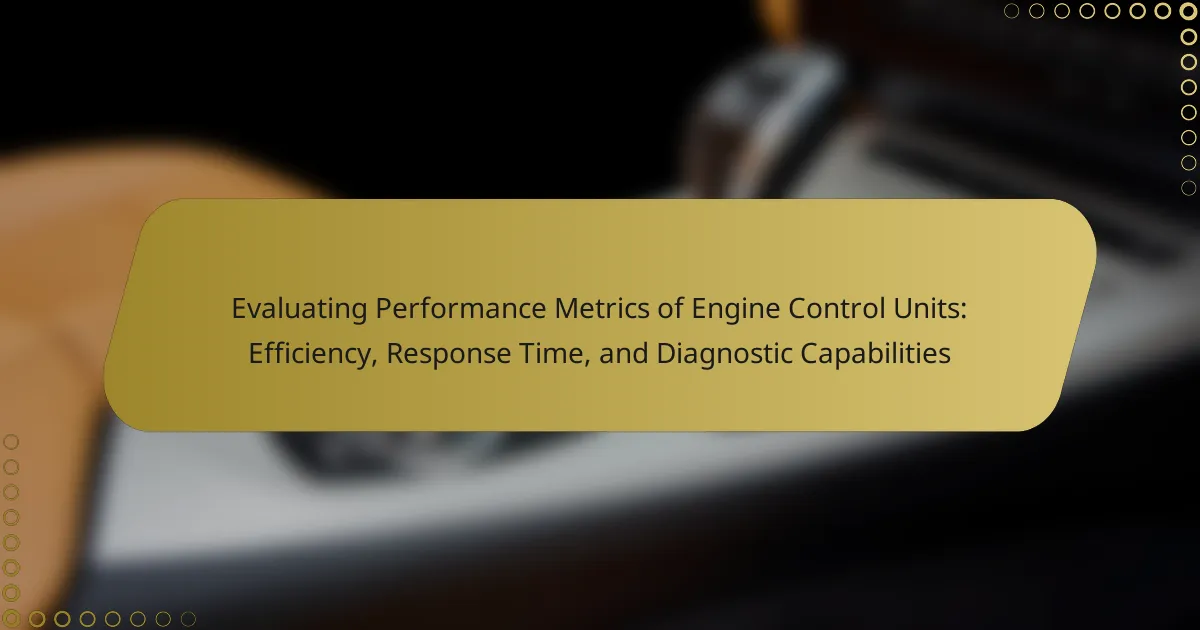Engine Control Units (ECUs) are essential electronic devices that manage engine performance in vehicles by processing input from various sensors to optimize parameters such as fuel injection, ignition timing, and emissions control. This article evaluates the performance metrics of ECUs, focusing on their efficiency, response time, and diagnostic capabilities. It discusses how advanced ECUs contribute to improved fuel economy and reduced emissions, achieving efficiency gains of up to 15% compared to traditional systems. Additionally, the article highlights the diagnostic functions of ECUs, including real-time monitoring, fault detection, and communication with diagnostic tools, which are vital for effective vehicle maintenance and performance analysis.

What are Engine Control Units and Their Role in Vehicles?
Engine Control Units (ECUs) are electronic devices that manage engine performance in vehicles. They receive input from various sensors to optimize fuel injection, ignition timing, and emissions control. ECUs process this data to ensure the engine operates efficiently and meets regulatory standards. They play a critical role in enhancing vehicle performance, fuel efficiency, and reducing harmful emissions. Modern vehicles may have multiple ECUs, each dedicated to specific functions. For example, the engine ECU works alongside transmission and brake control units. This integration allows for better overall vehicle dynamics and safety features. The effectiveness of ECUs is measurable through performance metrics like response time and diagnostic capabilities.
How do Engine Control Units function within a vehicle?
Engine Control Units (ECUs) manage the engine’s performance in a vehicle. They receive data from various sensors, such as temperature, pressure, and oxygen levels. The ECU processes this information to adjust fuel injection, ignition timing, and other parameters. This optimization ensures efficient combustion and reduces emissions. ECUs also perform self-diagnostic tests to identify issues within the engine system. They communicate with other vehicle systems for integrated performance. Research indicates that modern ECUs can process data in milliseconds, enhancing response time and efficiency.
What are the key components of an Engine Control Unit?
The key components of an Engine Control Unit (ECU) include the microcontroller, memory, input/output interfaces, and sensors. The microcontroller processes data and executes control algorithms. Memory stores the software and calibration data necessary for engine management. Input/output interfaces connect the ECU to various sensors and actuators in the vehicle. Sensors provide real-time data on engine parameters such as temperature and pressure. Each component works together to optimize engine performance and efficiency. The combination of these components allows the ECU to manage fuel injection, ignition timing, and emissions control effectively.
How do these components interact to control engine performance?
Engine performance is controlled by the interaction of various components such as the Engine Control Unit (ECU), sensors, and actuators. The ECU processes data from sensors that monitor parameters like air intake, temperature, and fuel levels. This data informs the ECU’s decisions on fuel injection timing and quantity. Actuators then adjust components like throttle position and fuel injectors based on the ECU’s commands.
For example, the throttle position sensor sends real-time data to the ECU. The ECU uses this information to optimize air-fuel mixture for efficient combustion. Additionally, the oxygen sensor provides feedback on exhaust gases, allowing the ECU to fine-tune the engine’s performance. This closed-loop system ensures that engine performance is responsive and efficient, adapting to changing conditions.
Research shows that precise interaction among these components can enhance engine efficiency by up to 20%. This is evident in modern vehicles that utilize advanced ECU algorithms to maximize performance while minimizing emissions.
Why are Performance Metrics important for Engine Control Units?
Performance metrics are crucial for Engine Control Units (ECUs) because they measure operational efficiency and system reliability. These metrics provide insights into how well the ECU manages engine performance under various conditions. For instance, metrics like fuel efficiency and response time are essential for optimizing engine performance. They help identify areas for improvement, ensuring that the ECU operates within optimal parameters. Moreover, performance metrics assist in diagnosing issues, allowing for timely maintenance and reducing downtime. Accurate metrics can lead to enhanced vehicle performance and compliance with emissions regulations. Research indicates that effective performance monitoring can improve ECU functionality by up to 30%.
What specific performance metrics should be evaluated?
Specific performance metrics to evaluate for Engine Control Units (ECUs) include efficiency, response time, and diagnostic capabilities. Efficiency assesses fuel consumption and power output, indicating how well the ECU optimizes engine performance. Response time measures the speed at which the ECU reacts to input changes, impacting throttle response and overall drivability. Diagnostic capabilities evaluate the ECU’s ability to identify and report faults, crucial for maintenance and reliability. These metrics are essential for ensuring optimal engine performance and vehicle safety.
How do these metrics impact overall vehicle performance?
Efficiency, response time, and diagnostic capabilities significantly impact overall vehicle performance. Efficiency metrics determine fuel consumption and energy utilization. Higher efficiency leads to better fuel economy and reduced emissions. Response time metrics affect how quickly the vehicle reacts to driver inputs. Faster response times enhance acceleration and handling, improving the driving experience. Diagnostic capabilities enable timely identification of issues, preventing performance degradation. Effective diagnostics lead to proactive maintenance, ensuring optimal vehicle operation. Collectively, these metrics contribute to a vehicle’s reliability, performance, and environmental impact.

What is Efficiency in the Context of Engine Control Units?
Efficiency in the context of Engine Control Units (ECUs) refers to the ability of the ECU to optimize engine performance while minimizing fuel consumption and emissions. This efficiency is achieved through precise control of fuel injection, ignition timing, and other engine parameters. High efficiency in ECUs leads to better fuel economy, reduced greenhouse gas emissions, and enhanced engine responsiveness. Studies have shown that advanced ECUs can improve fuel efficiency by up to 15% compared to traditional systems. This optimization is crucial for meeting regulatory standards and improving overall vehicle performance.
How is efficiency measured in Engine Control Units?
Efficiency in Engine Control Units (ECUs) is measured by analyzing fuel consumption, emissions, and performance metrics. Fuel consumption is quantified in liters per 100 kilometers or miles per gallon. Emissions are assessed based on the amount of pollutants produced per distance traveled. Performance metrics include engine response time and power output relative to input energy.
These measurements are often collected through onboard diagnostics and real-time data analysis. Testing protocols, such as the Worldwide Harmonized Light Vehicles Test Procedure (WLTP), provide standardized conditions for evaluating efficiency. Additionally, efficiency maps are created to visualize the ECU’s performance across different operating conditions.
The accuracy of these measurements is validated through controlled laboratory tests and real-world driving scenarios. This ensures that the data reflects the ECU’s efficiency under various conditions.
What factors influence the efficiency of an Engine Control Unit?
The efficiency of an Engine Control Unit (ECU) is influenced by several factors. Key factors include the quality of the software algorithms used. Efficient algorithms can optimize fuel injection and ignition timing, enhancing performance. Another factor is the hardware specifications of the ECU, such as processing speed and memory capacity. Higher specifications allow for faster data processing and improved response times. Additionally, sensor accuracy impacts ECU efficiency. Accurate sensors provide better data for decision-making, leading to optimized engine performance. Environmental conditions, such as temperature and humidity, also affect ECU performance. These conditions can influence sensor readings and overall engine operation. Regular software updates can improve ECU efficiency by refining algorithms and fixing bugs.
How can efficiency be improved in Engine Control Units?
Efficiency in Engine Control Units (ECUs) can be improved by optimizing software algorithms. Enhanced algorithms can lead to better fuel management and reduced emissions. Upgrading hardware components, like microcontrollers, can increase processing speed. This allows for faster data analysis and quicker response times. Implementing advanced diagnostic tools can identify inefficiencies in real time. Regular software updates can ensure that ECUs operate at peak performance. Additionally, utilizing machine learning can enable adaptive control strategies. These strategies can adjust to changing driving conditions, improving overall efficiency.
What role does Response Time play in Engine Control Units?
Response time in Engine Control Units (ECUs) is critical for optimal vehicle performance. It determines how quickly the ECU can process sensor inputs and execute commands. A faster response time enhances engine efficiency and improves driving dynamics. For example, modern ECUs can achieve response times as low as 1 millisecond. This rapid processing allows for timely adjustments to fuel injection and ignition timing. Consequently, vehicles with quicker ECUs experience better acceleration and reduced emissions. Research indicates that a 10% improvement in ECU response time can lead to a 5% increase in fuel efficiency. Thus, response time is a vital performance metric for ECUs, affecting both efficiency and overall vehicle operation.
How is response time defined in the context of Engine Control Units?
Response time in the context of Engine Control Units (ECUs) is defined as the duration taken by the ECU to process input signals and deliver output commands. This metric is critical for ensuring timely adjustments to engine performance. For instance, a shorter response time results in quicker throttle response and improved fuel efficiency. ECUs typically operate within a response time range of milliseconds, depending on the complexity of the task. Studies have shown that optimized response times can enhance vehicle performance and driver satisfaction. Manufacturers aim for minimal latency in ECU operations to meet stringent automotive standards.
What are the consequences of delayed response times?
Delayed response times in engine control units can lead to significant performance issues. These delays can cause engine misfires, reduced fuel efficiency, and increased emissions. For instance, a study from the Society of Automotive Engineers found that a 100-millisecond delay can result in a 5% increase in fuel consumption. Moreover, delayed responses can hinder real-time diagnostics, leading to undetected faults. This can escalate repair costs and extend vehicle downtime. Additionally, prolonged delays may affect driver safety by impairing vehicle handling and responsiveness. Thus, timely responses are crucial for optimal engine performance and overall vehicle safety.

What are the Diagnostic Capabilities of Engine Control Units?
Engine Control Units (ECUs) have several diagnostic capabilities. They monitor engine performance in real-time. ECUs can detect faults and store diagnostic trouble codes (DTCs). These codes help technicians identify issues quickly. They also perform self-tests to ensure all systems function correctly. Additionally, ECUs can communicate with diagnostic tools via standardized protocols like OBD-II. This communication allows for detailed analysis and troubleshooting. The ability to log historical data aids in understanding long-term performance trends. Overall, ECUs play a critical role in vehicle diagnostics.
How do Engine Control Units perform diagnostics?
Engine Control Units (ECUs) perform diagnostics through onboard self-testing and real-time monitoring. They continuously assess various engine parameters using sensors. When a fault is detected, the ECU generates Diagnostic Trouble Codes (DTCs). These codes help identify specific issues affecting engine performance. The ECU stores DTCs in its memory for retrieval during diagnostics. Technicians can access this information using diagnostic tools. The process allows for efficient troubleshooting and maintenance. Research indicates that effective ECU diagnostics can improve vehicle reliability and reduce repair costs.
What types of faults can Engine Control Units detect?
Engine Control Units (ECUs) can detect various types of faults related to engine performance. These include sensor malfunctions, such as faulty oxygen sensors or mass airflow sensors. ECUs also identify issues in fuel delivery, including injector failures or fuel pump problems. Additionally, they can detect ignition system faults, such as spark plug issues or ignition coil failures. Other faults include exhaust system problems, like catalytic converter failures. Furthermore, ECUs monitor for electrical faults, such as wiring issues or short circuits. These detection capabilities enhance vehicle diagnostics, allowing for timely repairs and maintenance.
How does diagnostic information benefit vehicle maintenance?
Diagnostic information enhances vehicle maintenance by providing real-time insights into a vehicle’s performance. This data helps identify issues before they escalate into major problems. For instance, diagnostic tools can reveal error codes that indicate specific malfunctions. By addressing these issues promptly, vehicle owners can avoid costly repairs. Additionally, regular diagnostics can improve fuel efficiency by ensuring optimal engine performance. Studies show that vehicles maintained with diagnostic information can have a longer lifespan. This proactive approach leads to safer driving conditions and improved reliability. Overall, diagnostic information is crucial for effective vehicle maintenance.
What are the best practices for evaluating Engine Control Unit performance?
The best practices for evaluating Engine Control Unit (ECU) performance include testing efficiency, monitoring response time, and assessing diagnostic capabilities. Efficiency can be measured by analyzing fuel consumption and emissions data during various operating conditions. Response time is evaluated by measuring the delay between sensor input and actuator response, ensuring timely adjustments. Diagnostic capabilities are assessed through the use of onboard diagnostics (OBD) systems, which provide fault codes and performance data. Regular software updates and calibration checks are essential to maintain optimal ECU functionality. These practices help ensure that the ECU operates at peak performance, enhancing overall vehicle efficiency and reliability.
How can regular assessments improve Engine Control Unit functionality?
Regular assessments can significantly enhance Engine Control Unit (ECU) functionality. These assessments identify performance issues and optimize system parameters. Regular evaluations ensure that the ECU adapts to changing conditions and maintains efficiency. They can also calibrate sensors and actuators for improved accuracy. Enhanced diagnostic capabilities result from consistent monitoring, allowing for early detection of faults. Studies show that regular assessments can reduce maintenance costs by up to 30%. This proactive approach extends the ECU’s lifespan and improves overall vehicle performance.
What tools are available for performance evaluation of Engine Control Units?
Tools available for performance evaluation of Engine Control Units (ECUs) include diagnostic scanners, software simulation tools, and data logging devices. Diagnostic scanners provide real-time data from the ECU, allowing for the assessment of performance metrics. Software simulation tools enable engineers to model ECU behavior under various conditions, facilitating performance analysis. Data logging devices capture ECU data during operation, which can be analyzed for efficiency and response time. These tools collectively enhance the understanding of ECU performance and support optimization efforts in automotive applications.
Engine Control Units (ECUs) are critical electronic devices that manage engine performance in vehicles by optimizing fuel injection, ignition timing, and emissions control through real-time data from various sensors. This article evaluates the performance metrics of ECUs, focusing on efficiency, response time, and diagnostic capabilities, which are essential for enhancing vehicle performance and compliance with regulatory standards. Key components and their interactions are explored, alongside the importance of performance metrics in diagnosing issues and improving overall vehicle reliability. Additionally, best practices for assessing ECU functionality and tools for performance evaluation are discussed to ensure optimal operation.
